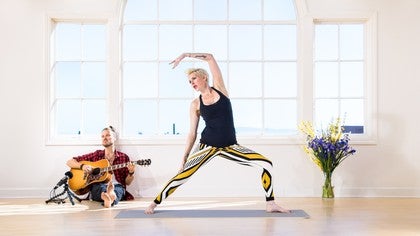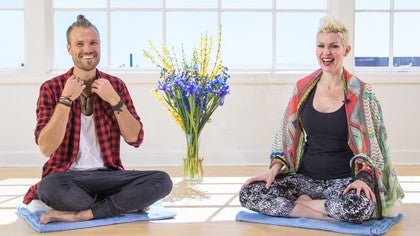Description
About This Video
Transcript
Read Full Transcript
(Waves crashing) How lucky are we? (laughs) Pretty lucky. Pretty lucky. Thank you so much Sadie, this has been amazing. I've just been having the best time. I'm so glad.
Especially so much of the beauty of what you've been sharing has been this courage to show up vulnerable. Vulnerable is absolutely key to transformation. It's like an essential ingredient. Now what first drew me into conversation with Sadie, I happened to be up in San Francisco attending her class up at the Yoga General Conference and I was so moved when you had this big, bold statement in your translation of Sutra 2.1, and when we're talking about the Sutras we're usually talking about Patanjali's yoga sutras. Sutra 2.1, you made this outrageous statement of translating ishvara pranidhana which so normally gets translated as "surrender", as "action".
And I wanted to just sit there in support of you and yet there this, I gotta ask her-- How'd she come to that? How did she get to that? Because translation is so mystical and magical, so ever since you shared your choice of defining this as action within the context of the tapas and the svadhyaya, everything has changed for me. Can you bring a bit of that conversation to our friends so that they can catch up? Yeah, absolutely.
Well, I love that too, because we were in this big conversation about it and mostly people will just sit there and go, "oh, okay," and move on. But she was like, "wait a minute, tell me more," and that was wonderful. We got into this great conversation about the yoga, the three steps to transformation as set forth by Patanjali in the Yoga Sutras, and this is a whole notion that's been dissected a lot in yoga philosophy, and I think one of the most foundational road maps to moving into your truth. To dissolving or working with these kind of roadblocks that we come up upon, then how do we act as ourselves? How do we as Torold might say become that full body expression?
Right? And so the three steps are tapas, and we hear about this one a lot. This is like the fire of transformation and everyone says that. Each one of these is so multifaceted though, It's like a jewel with all the different faces. You can look at aspects.
I guess I'll just go through them all, because for me that's of interest right now. And as we move through life as yoga people or as human beings finding our full expression. So tapas to me is both active and a surrender. Both active and passive. In fact, I'm now coming to the point where I think all three of them contain it all.
And it's just how you're participating. So tapas fire transformation; doing something differently. That push that has to occur when you've been going in a direction that maybe isn't exactly right for you, or it's painful or you're suffering, and to start moving things in a different way. That is just the law of nature of physics as well. You have to give a harder push, right?
So there is that kind of action. Dedicating to doing the work, involved in being your best, being your highest. However, in doing the work, I think there's a lot of surrender in that. Because sometimes doing the work isn't doing more, it's being more. And we're seeing that a lot in this course.
So I'm just getting so excited about the fact that maybe we could work smarter and not harder. This is also moving, shaking up your energy and all that kind of fiery element and walking into the fire at all like sitting here right now and I just said "Hey, why don't you come up and have the conversation with me?", and she wasn't planning on it. And she said "You know what, yeah, I'll show up for that." Tapas for me is showing up. And how. Svadhyaya then is once you come into this new space, and you've got some intention, then really going inside.
Listening to yourself, and deeply listening. Not just to the mental voices that happen, As Torold would say, the automatic brain. The automatic thoughts, feelings and sensations. But even more profound than that, what's your truth at all? What's the core relationship saying?
And we as yogis might even say What's spirit saying? What's God saying? What's the divine? What's love? You know, what would love do?
That's very Svadhyaya. Hmm, I don't know. What would love in me do? What would compassion - What would my saucha, my truth do now? Or not do now also.
So in that idea of inner inquiry, We have both an action, because we're going to sit and actually try to actually breathe into the belly, we're gonna go inward, we're doing something, we're allowing the space to occur, but then, it's a being-ness. And a surrender. And a listening on a level many of us maybe touch into here and there. And then Isvara Pranidhan would be - usually we think of it as "surrender the outcome to the divine, surrender to the universe." But it's not like just abdicating your responsibility to take your own right aligned action. Or to express.
So I can go inside all I want in a singing situation, I can breathe, I can sit in Steve, my inner middle brain armchair that I found. I can do my stuff, and be here. And take a deep inhale. Svadyaya. But what happens on the exhale? Am I creating a sound?
Am I expressing myself? It is an action, it is something that you choose to do. It's also something that you allow to be. Like opening up to the divine flow is an action. You're doing something to open up, because you're not restricting, but you're also not doing it at all.
Therein lies the rug. (laughter) I hear you so beautifully, and I think you might even have mentioned sutra 1.12 during the practices, I'm not sure, but sutra 1.12. Perfect - absolutely required is a perfect balance between dilligent, attentive work, abhyasa and what often gets defined as surrender, or sometimes disentanglement, or sometimes that awkward translation of detachment, which always makes it seem like you don't care. You don't care. But it's not true! So it's a terrible transition, but vairagyabhyam.
Which is easy to remember because it sounds like Viagra and you're always like "I can't say that right". (laughs) But you weaved that in beautifully so it's perfect. Yes, it's a very exciting state to be in for a longer time the more you practice it. (laughs) But that perfect place of the dilligent, attentive effort of what you and Torold have been talking about, about allowing. Allowing.
The increasing of the spaciousness for more. Because as yogis, when I'm trying to reduce what we're doing we're trying to increase our capacity. Yes. Yes. And I do think as yogis, we've been going about it a little bit ineffectively often. One aspect is that we're doing too much.
We're trying to do it all. We're trying to think about it, and dissect our past and figure out where the roots of the fear comes from, like let's say I feel blocked about singing today. I'm scared. Well I'm gonna go for five hours now and trace back the roots of that fear to third grade, or wherever it came from. And really sit with it, and do mantras for fear and all of this stuff, but what if I just sat and said "oh, okay, well my dedication, my action is to sit here and start breathing into my belly and allow more, and then I'm just gonna sing.
I'm gonna express from center." Therefore the fear that was blocking me is no longer blocking me. So it is that dance between the two. And sort of the sutra that follows 2.1 which you just so - thank you for such that beautiful unpacking I like to translate. Yeah, so that sutra that follows that second one, and the purposes of the techniques of yoga, what you just so beautifully laid out, are to reduce the grip, which the yogis define as the kleshas, and increase the experience, or increase the conditions under which samadhi. And then the way it was happening yesterday, between you and Torold, that to me - I love the definition of samadhi as rapture or absorption.
That's what was happening. Yes. And in that state of absorption, nothing can touch you. It's so amazing, if I get those external voices involved, if I live more in the periphery of my brain more in the periphery of my sensation, the periphery of what other people think outside of me, I would never have been able to do that yesterday. I have been historically very afraid when stepping up to perform in front of people.
When it comes to singing, I'll shake, I'll feel really anxious and I'll have to push through that. But instead, choosing to be in such a way, and not breathe up here in the chest, but locate it down in the belly, to sit back. To use that simple mental sitting as the conditions under which I am more likely to get out of my own way and get back into my center, And therefore, the singing was effortless. And it sounded better, and it felt amazing, And that's what I would call samadhi. And if you were up here close to Torold, I could only see him, but I was also feeling the same way, you would see us almost in this ecstatic channeling state of some sort, where our eyes are kind of rolling back, and we're just feeling and we're being moved.
And just trying to - I think really for me it's swim with that. That state is very close to what you would call rapture. And we're expressing from there. Yogis who tour and show up in cities to big crowds often get compared to rock stars. And yet, when I've gotten so much from this conversation between you and Torold, and when I say conversation, I also mean the singing, the sounding and what you shared.
Is that the presenter, the entertainer the person that looks like they're showing up, there's this beautiful tension between what it might look like and what it really feels like. Yeah, absolutely. It's very interesting to be me and to be called that. Like the rockstar of yoga, or whatever. And I've had people write me online who don't know me, and kind of criticize how I look and how I am because they're like "nice branding", you know?
Like "Oh, you decided to do this to have an image, and then they called you the rockstar of yoga." But what they don't know is that - and I told you this very early on - ever since I was old enough to dress myself and dye my hair myself, I was doing it. I had purple hair when I was 15 years old before I even knew what yoga was. I was always that kind of musically oriented, gypsy, nature girl going to sleep many nights a week and definitely weekends in my parents' van because they were in some pub or bar or event place singing in their band. And listening to the music of my mom singing on the mic, that's how I grew up. So I had told you, I feel like I was a musician that put on more of a yoga teacher's outfit, than a yoga teacher trying to learn how to sing a little bit.
Not that the yoga teaching is a put-on, it's not. It's coming from my core as well, but I've always been that. And I think the true rockstar nature is in all of us. Not just to be like "rock and roll!" I'm a loud - I'm more of kind of a big energy person anyway. Some people are gentle rockstars, but we've all got that ability to access our truth and to share that in a way that's so resonant for people it's so magnetic.
When you're vulnerable in your strength and you're at your core. And you're actually brave enough to move from there. To sing from there, to speak from there, to take action from there. This is all the three steps to transformation. And so yeah, maybe you see me as the rockstar of yoga, but you're just calling me what I already was in my own way.
You know? Don't get it twisted. Beyonce: â?« You must not about me â?« Let's pull in a different text for the fun of it. Okay. Our friend the Bhaghava Gita. Alright! And our friend inscription Arjuna. Oh yeah.
My takeaway at this point from the Bhaghava Gita is really this call of aligning with your true dharma. Dharma as your responsibility to be yourself. Your responsibility to be in order with the cosmos. And this translation of this word ahimsa, which so often gets translated as nonviolence and usually we joke that yogis end up fighting about what that means. Usually about what we eat. Yes.
But if we define ahimsa as nonviolation, so this call to not violate the truth of you that is wanting to live to be seen. What I've so appreciated and received as such a gift from you Sadie, and you're sharing of your deepest most personal work is this call and this courage to be ourselves. Can you help us with just a few more words in this direction? Sure, wow. I mean, let's take a moment with how you just translated ahimsa.
Nonviolation of your own path. Of what's right for you in this moment. I have had a real problem coming into the yoga world and being someone who is my own person. Who doesn't follow all the norms set forth by I would say the kind of polar yoga crowd. A lot of people will comment on Facebook or say things to me and say "that's not yogic".
What you're doing or what she's doing or what he's doing isn't yogic. I always say "hey it's really awesome if you put the words 'for me' at the end of any statement like that". It makes it much more yours. Take responsibility. That's not yoga for me.
That's why I don't do it, right? In my opinion. So I like to wear makeup, I like a good steak and vino, I practice yoga my own way. And I speak my truth. It's not anyone else's.
And so yes, I think it's so, so important that we look at look at something like this idea of nonviolation and to say what are you currently participating in? What am I? What are you? In our ways today that are kind off alignment off your vibe, off your resonance. I can sing from my mind, and my upper body and never get into my belly and it's not going to sound as resonant as it could. I can teach a style of yoga that I'm not in alignment with because I think that people are gonna like it and I'll make money.
I can not wear makeup because that's not yogic to one person out there in the yoga sphere, or whatever it is. But I choose not to, and it's exciting to me. I'm so excited right now because it's guided my whole life. When I'm off alignment with myself it feels like it. I don't feel fully satisfied I'm like "It's not quite me." And so I do what I can to get back and I think that's an individual path.
So when we're talking about being a rockstar, your rockstar doesn't look like anyone else's. Just like your voice doesn't look like anyone else's. This yoga teacher, that yoga teacher. This singer, that singer. This person next to you, this bright shiny thing and you're shining in a different way.
That's why this whole experience I think with Torold and you and me, and you there is really just to figure out who you are and rock it as much as you can, because that's the joy. Right there, that's the satisfaction. that's how you dissolve some scars that aren't serving you. Just to be the most full you you can. So in here, we're gonna rock who we are.
You, you and me. That's it, that's what we're here for. I think you just summarized the ex-thousand year tradition perfectly. Figure out who you are, and rock it. Rock it.
Namaste. (Laughs) I rock today.
Rock Yourself
Comments
You need to be a subscriber to post a comment.
Please Log In or Create an Account to start your free trial.













